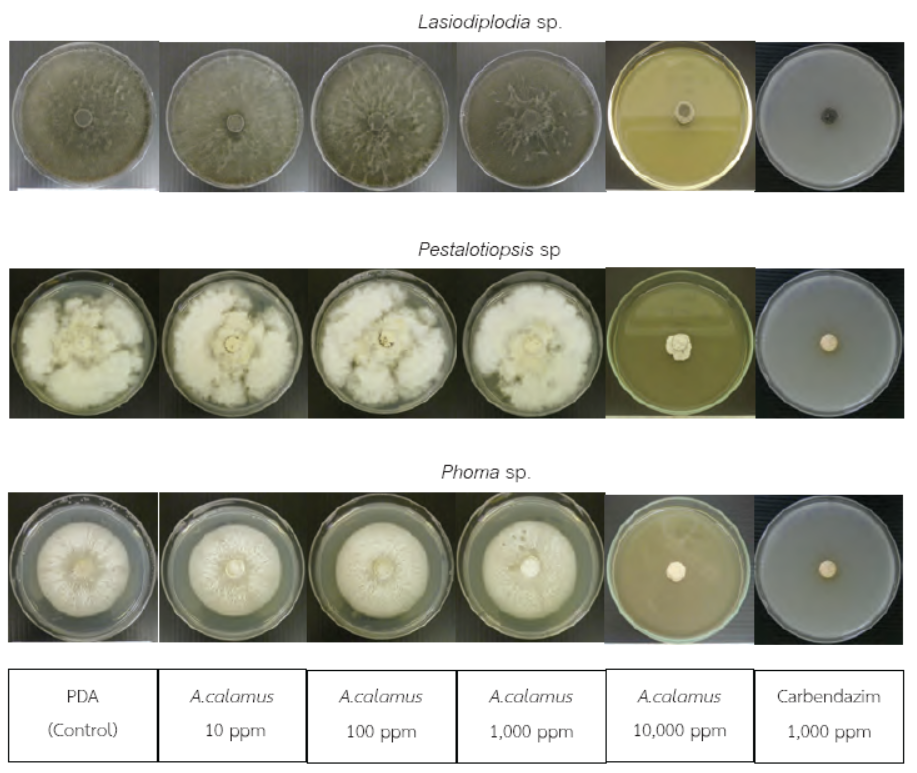The study on efficiency of Acorus calamus L. extract against fruit rot fungi isolated from lychee
DOI:
https://doi.org/10.60136/bas.v3.2014.194Abstract
This research was to study the effect of Acorus calamus L. (Sweet flag) extract on the mycelial growth inhibition of 21 strains of fruit rot fungi. Among these, 6 were reference strains and 15 were strains isolated from lychee fruit peels. The isolation of fungal strains was performed by using tissue transplanting technique, proved to cause fruit rot disease according to Koch's Postulation method. The fungal strains were classified using a molecular technique. The ability of A.calamus extract by 95% ethanol on the mycelial growth inhibition was compared with commercial fungicide, carbendazim. The experiment was performed in 2 ways, on Potato Dextrose Agar (PDA) plates and on lychee fruit. The test on PDA plates was performed according to Poisoned food technique. Various concentrations (10, 100, 1,000, 10,000, 20,000, and 30,000 ppm) of the extract were determined for antifungal activity on PDA. The result indicated that all fungal strains were sensitive to A. calamus extract at the concentration of 10,000 ppm upward. The average mycelial growth inhibition of the extract at 10,000 ppm was more than 80% whereas that of carbendazim at 1,000 ppm was 70.26%. The extract at 10,000 and 20,000 ppm were tested for the mycelial growth inhibition on lychee friut. The lychee fruit were cleaned, sprayed with A.calamus extract, punched with the needle, and inoculated with the tested fungi. All inoculated fruit were incubated in an appropriate condition for 7 days. The growth of the tested fungal mycelium were then observed. The result showed that the extract delayed the mycelial growth of 15 strains on lychee fruit whereas carbendazim inhibited 21 strains. Therefore, the A.calamus extract has a potential to be used to control fruit rot fungi in lychee fruit.
References
นิพนธ์ วิสารทานนท์. โรคไม้ผลเขตกึ่งร้อนโรคทับทิม น้อยหน่า ลำไย ลิ้นจี่ ส้ม องุ่น และอะโวกาโด. กรุงเทพมหานคร: ภาควิชาโรคพืช คณะเกษตร, มหาวิทยาลัยเกษตรศาสตร์, 2542.
รัมม์พัน โกศลานันท์, บุญญวดี จิระวุฒิ และอารีรัตน์ การุณสถิตชัย. การใช้สารธรรมชาติเพื่อควบคุมโรคและยืดอายุการเก็บรักษาลิ้นจี่. กรุงเทพมหานคร: สำนักวิจัยและพัฒนาวิทยาการหลังการเก็บเกี่ยวและแปรรูปผลิตผลเกษตร, 2549.
JIANG, Y., et al. Postharvest biology and technology of litchi fruit. Food, Agriculture and Environment, 2003, 1(2), 76-81.
SIGMA-ALDRICH. Carbendazim. Material Safety Data Sheet [Onlinel]. 2013. [viewed 16 April 2014]. Available from: http://www.rayfull.com/UploadFiles/PDF/2013681451543.pdf
สำนักงานข้อมูลยาสมุนไพร คณะเภสัชศาสตร์ มหาวิทยาลัยอุบลราชธานี. ว่านนํ้า [ออนไลน์]. 2553. เข้าถึงจาก: http://www.thaicrudedrug.com/main.php?action=viewpage&pid=124
MUNGKORNASAWAKUL, P., et al. Inhibitory effect of Acorus calamus L. extract on some plant pathogenic molds. International Conference on Medicinal and Aromatic Plants Possibilities and Limitations of Medicinal and Aromatic Plant Production in the 21st century. Budapest: International Society for Horticultural Science, 2002, pp. 341-345.
AGRIOS, G.N. Plant pathology. 4th Ed. San Diego : Academic press, 1997.
WHITE, T. J., et al. Amplification and direct sequencing of fungal ribosomal RNA genes for phylogenetics. PCR protocols. USA : Academic Press, 1990, pp 315-322.
TASKEEN, Un-Nisa., et al. “In vitro inhibitory effect of fungicides and botanicals on mycelial growth and spore germination of Fusarium oxysporum.” Journal of Biopesticides, 2011, 4(1), 53-56.
KMETZ, K. T., A. F. SCHMITTHENNER., and C. W. ELLETT. Soybean seed decay: Prevalence of infection and symptom expression caused by Phomopsis sp., Diaporthe phaseolorum var. sojae, and D. phaseolorum var. caulivora.” Phytopathology, 1978, 68(6), 836-840.
EHTESHAMUL-HAQUE, S., and A. GHAFFAR. New records of root infecting fungi from Pakistan. Pakistan Journal of Phytopathology, 1994, 6(1), 50-57.
ผ่องเพ็ญ จิตอารีย์รัตน์, เฉลิมชัย วงษ์อารี และ ธิติมา วงษ์ชีรี. ประสิทธิภาพของสารสกัดจากพืชบางชนิดร่วมกับสารเคลือบผิวที่มีต่อโรคแอนแทรคโนส และขั้วผลเน่าของมะม่วงระหว่างการเก็บรักษา. วารสารวิจัยและพัฒนา มจธ., 2542, 22(3), 77-92.
PHONGPAICHIT, S., et al. Antimicrobial activities of the crude methanol extract of Acorus calamus Linn. Songklanakarin Journal of Science and Technology, 2005, 27(2), 517-523.
พรประพา คงตระกูล และ สรัญยา ณ ลำปาง. ลักษณะของเชื้อรา Colletotrichum gloeosporioides ที่ต้านทานสารคาร์เบนดาซิม. วารสารเกษตร, 2553, 26(3), 203-212.
ณัฐพงษ์ นวลดี และคนอื่นๆ. ลักษณะของเชื้อรา Cercospora ที่ต้านทานสารคาร์เบนดาซิมสาเหตุโรคใบจุดของผักกาดหอมในจังหวัดเชียงใหม่. วารสารวิจัย มข. , 255 3, 15(11), 1053-1060.
SARIAH, M. Detection of benomyl resistance in the anthracnose pathogen, Colletotrichum capsici. Islamic Academy of Sciences, 1989, 2(3),168-171.
RATTANAKREETAKUL, C., et al. Efficacy test on dipping substances to control anthracnose disease on mango cv: Chok-Anan. Proceedings of 41st Kasetsart University Annual Conference. 2003. 3-7 February; Bangkok : Kasetsart University. pp.371-378.

Downloads
Published
How to Cite
Issue
Section
License
Copyright (c) 2022 Bulletin of Applied Sciences

This work is licensed under a Creative Commons Attribution-NonCommercial-NoDerivatives 4.0 International License.









